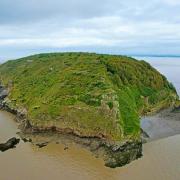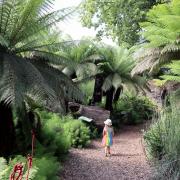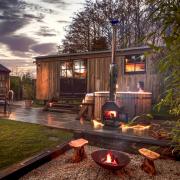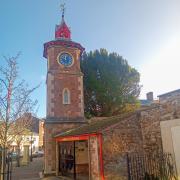A look at the history of the World Heritage City of Bath.
Meditating with Zen monks submerged in a natural hot pool on Hokkaido Island while the Sea of Japan fades from tangerine to cobalt... or swimming in a steaming stream gushing from a mountainside in the lee of looming Icelandic glaciers. What can sacred Britain offer, to compete in the premier league of great hot bathing experiences of the world?
The original Bath, that’s what. Every day, more than a million litres of water bubble up from the bowels of the earth at a toasty 47°C, from three springs in what is now the centre of the city of Bath. These are the only hot springs in the British Isles and have been sacred from prehistoric times, with people placing faith in their curative powers.
Looking out across the World Heritage City of Bath, my vantage point was the open-air rooftop thermal pool at Thermae Bath Spa where I sat pensively poaching. This is the mother of all baths, I concluded, trying to imagine the hot rivulets coursing through the rolling English countryside centuries ago, when it was as pristine as the Icelandic wilderness.
What would the Romans or Georgians have made of all this modern spa gismology, I pondered. This is the place that, for me, provides the most powerful allure of Thermae Bath Spa. Looking out across the townscape, I was reminded how innovative the technology was that the Romans brought to the hot springs when they built the baths 2,000 years ago. Similarly, the Palladian architecture of Ralph Allen and John Wood was cutting edge for its time.
Bath’s story starts with Bladud, the legendary King of the Britons and father of King Lear, who in his youth was sent to study in Athens and returned with leprosy. As a leper he was banished from his position at court and left the royal palace disguised as a nomadic swineherd with a herd of pigs which were also victims of some dreadful pestilence.
Roaming the land, Bladud reached the Vale of Avon where his pigs rolled in some hot mud bubbling up from underground. When he saw how they seemed to have been cured from their scabs and sores, Bladud followed their example, bathed in the murky hot water and was also healed. He returned to court in rude health and duly inherited the crown. King Bladud founded a city at Bath and dedicated the curative powers of the sacred hot springs to the Celtic goddess Sul.
For centuries the ancient Britons remained faithful to Sul, as did the Romans after their conquest of Britannia in the 1st century AD. The Romans raised a magnificent Classical temple on the site and named it Aquae Sulis. They used their technology to construct a full-scale bathing complex, which became a place of rest and recreation for legionaries fighting on the northern frontier. Soon, bigwigs arrived from all over the empire, and Bath entered its first phase as a major visitor destination.
After the disintegration of the Roman Empire, the baths fell to ruins and the springs silted up. Nevertheless, there is evidence of pilgrims to a medieval monastery that flourished in Bath, believing in the healing powers of the hot water. Following the Dissolution of the Monasteries, there was a brief period in which the infirm and other visitors were attracted to a cluster of guesthouses around the hot pools.
Then came the great revival. During the 18th century, Bath bloomed into the most fashionable city in the land, where the high-born and wealthy hob-nobbed in the imperious Grand Pump Room, took the waters and were carried around town in sedan chairs. This was the era in which the city first lent its name to the English lexicon, both as a noun and a verb. We have bathtubs in our bathrooms. We bath and we bathe.
Novelist Jane Austen, a Bath resident, provided some caustic commentary on the foolish pomp of these times. However, her lesser-known contemporary Tobias Smollett observed the wealthy, poor and sick alike, taking the waters. In 1771 he wrote, ‘There you see the highest quality and lowest tradesfolk, jostling each other without ceremony hail-fellow well met.’
This was the era when a triumvirate of movers and shakers tore down medieval Bath and replaced it with a crucible of architectural splendour. Richard ‘Beau’ Nash, Master of Ceremonies in the city, controlled society; Ralph Allen was the money man, visionary and owner of the stone quarries; and architect John Wood (and later, his son John Wood the Younger) built the crescents, arcades, squares, circuses and Palladian embellishments, using local, honey-coloured limestone.
On the therapeutic side, Bath Royal Mineral Water Hospital opened in 1739, and continued to treat patients with the natural thermal water until 1976. By this time, the concept of the spa as a serious source of cure and wellbeing had virtually disappeared in Britain – astonishing as this may seem to people from parts of the world where spas are a central feature of healthcare.
However, despite the fact that the global concept of the therapeutic spa hails from Bath, the water was off-limits for nearly 30 years. Bathing in the reconstructed Roman Baths, 2,000 years after their initial construction, finally ended in 1978 after a health scare. The springs which spawned the city and drew millions to Bath over the ages were simply left to flow, like worthless effluent, into the River Avon. An instance if ever there was one, of throwing the baby out with the Bath water.
In part it may have been a feeling that the hot springs, wards of Sul and amniotic fluid of Bath’s birth, had been treated with shameful disrespect, that led to the decision of the Millennium Commission in 1997 to fund the extravagant and forward-looking project which finally opened as the new Thermae Bath Spa in 2005.
Practicalities
Bath Spa is 120 miles west of London, reached via the M4 motorway. It is on the main train line between London Paddington and Bristol. For tourist information, contact Visit Bath (Website: visitbath.co.uk).
Where to stay & eat
Royal Crescent Hotel 16 Royal Cres, BA1 2LS. Tel: 01225 823333. Website: royalcrescent.co.uk.
Magnificent, luxurious and expensive. Superlative rooms, restaurant and spa on Bath’s most famous crescent.
Springs Thermae Bath Spa, Hot Bath St, BA1 1SJ. Tel: 01225 331234. Website: thermaebathspa.com. Cafe and restaurant serving healthy snacks and dishes to spa users. Reasonable wines.
The Pump Room 39 Stall St, BA1 1LZ. Tel: 01225 444477. Website: thepumproombath.co.uk.
Morning coffee, lunch and afternoon tea to the strains of stringed instruments in the neo-Classical salon where Jane Austen observed her fellow bathers. Open to all.
Extracted from Britain's Sacred Places: A Guide to Ancient and Modern Sites That Stir the Soul by Martin Symington (published by Bradt Guides, 2022).




























